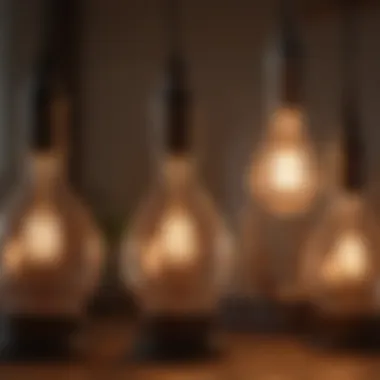Where to Buy Heat Lamp Bulbs: A Complete Guide


Intro
Heat lamp bulbs play a crucial role in various fields, especially in agriculture and horticulture. They provide essential warmth for young plants, protect animals from cold, and enhance growth efficiency. Understanding where to purchase these bulbs is vital for professionals and enthusiasts alike. This guide explores different buying options, giving you the tools to make informed decisions.
Key Concepts and Terminology
Basic Definitions
Heat lamp bulbs are specialized light sources designed to emit heat. Typically, they are incandescent or halogen bulbs that generate warmth alongside light. Common types include infrared bulbs and ceramic heat emitters.
Choosing the right type of heat lamp is essential based on the specific needs of plants or animals. For instance, infrared bulbs are often favored in veterinary settings due to their penetrating heat.
Historical Context
The use of heat lamps dates back to the 19th century. Initially developed for medical purposes, they made their way into agricultural settings as their effectiveness became evident. Over the decades, innovations have expanded the variety and efficiency of these bulbs, catering to diverse applications in today’s farming and horticultural practices.
Recent Innovations and Trends
Technological Advancements
Advancements in technology have led to more energy-efficient options. LED heat lamps are gaining popularity due to their lower energy consumption and longer lifespan compared to traditional bulbs. These innovations also reduce operational costs, which is favorable in budget-sensitive environments.
Sustainable Practices
Incorporating sustainable practices has become essential in modern agriculture. Many vendors now offer eco-friendly heat lamp bulbs that minimize environmental impact. These products not only abide by energy efficiency standards but also contribute to a greener approach to farming and gardening.
Practical Applications and Techniques
Step-by-step Guides
Before purchasing heat lamp bulbs, consider the following steps:
- Identify the Purpose: Determine whether you need the bulbs for plant growth, animal care, or other specific uses.
- Choose the Right Type: Research different types of bulbs suitable for your needs.
- Evaluate Brand Reputation: Look for vendors renowned for quality and reliability.
- Check for Certifications: Ensure the bulbs meet safety and performance standards.
Case Studies
Many horticulture enthusiasts have reported positive growth results using specialized heat lamps. For example, a local farmer using ceramic heat emitters found a marked improvement in seedling survival rates during colder months.
"Using the appropriate heat lamp can make a significant difference. The right bulb ensures optimal temperatures for plants and animals alike."
End
This guide has outlined essential information regarding where to buy heat lamp bulbs, offering insights into types, uses, and purchasing considerations. By familiarizing yourself with the options available, you can make informed choices that cater to your agricultural or horticultural pursuits.
Preamble to Heat Lamp Bulbs
Heat lamp bulbs play a crucial role in various applications such as agriculture, horticulture, and even in home settings for comfort. This section aims to outline the significance of these bulbs, focusing on their function in providing warmth and facilitating growth in plants and animals. For someone in agriculture, understanding heat lamp bulbs is essential as they can directly impact the health of crops and livestock.
Definition and Purpose
Heat lamp bulbs are specialized bulbs designed to emit heat, typically in the infrared spectrum. Their primary purpose is to provide warmth, which is beneficial in various scenarios. For example, they are commonly used in brooding facilities for chicks, helping to maintain the necessary temperature for their growth. Similarly, heat lamps are utilized in greenhouses to extend the growing season of plants, especially during colder months.
Types of Heat Lamp Bulbs
Understanding the various types of heat lamp bulbs can greatly aid in making informed purchasing decisions. The most common types include incandescent, halogen, and LED heat lamp bulbs.
Incandescent
Incandescent bulbs are the traditional choice for heat lamps. They generate heat by passing electricity through a filament. The primary characteristic of incandescent bulbs is their ability to produce a warm glow, which many users find appealing. They are cost-effective and widely available, making them a popular choice in both commercial and residential settings. However, they tend to consume a lot of energy and have a shorter lifespan compared to other options.
Advantages include their low initial cost and ease of replacement. However, the disadvantages involve higher energy consumption and heat output that may not be ideal for all environments.
Halogen
Halogen bulbs are a refined version of incandescent bulbs. They contain a small amount of halogen gas which increases their efficiency. The key characteristic of halogen bulbs is their bright, clear light, which many people argue is superior for certain applications. They warm up quickly and have a longer lifespan than standard incandescent bulbs.
Their unique feature is their lower energy consumption while providing the same amount of heat. However, they can become hot to the touch, which necessitates caution during use.
LED


LED heat lamp bulbs represent the latest technology in heating solutions. They are increasingly gaining popularity for their energy efficiency and longevity. LED bulbs use a fraction of the energy consumed by incandescent or halogen bulbs and can last up to 25 times longer. The primary characteristic of LED bulbs is their low heat production alongside effective heating capabilities.
While they may be more expensive upfront, their long-term cost-effectiveness is significant. The only drawback can be initial resistance to changing from traditional bulbs due to the higher initial cost.
In summary, evaluating these types of heat lamp bulbs involves considering their respective benefits and limitations in relation to the specific needs of the user.
Understanding Heat Lamp Specifications
Understanding the specifications of heat lamp bulbs is essential for anyone in agriculture or horticulture. These specifications ensure that the bulbs selected meet the specific heating requirements of the plants or animals involved. There are several key factors to consider, including wattage, color temperature, and durability. Each element plays a significant role in the effectiveness of the heat lamp, helping you choose the best option for your needs.
Wattage Considerations
Wattage directly correlates with the amount of heat produced by a heat lamp bulb. When selecting a bulb, it is vital to understand your wattage requirements. This is not a mere preference but should align with the specific heating needs of your environment. For instance, different plants or animals may require varying levels of warmth. Most bulbs typically range between 100 to 250 watts.
Higher wattage bulbs provide more heat but also consume more energy; this can lead to increased electricity costs. Hence, it is essential to strike a balance. Consider the size of the area you need to heat—larger spaces may necessitate higher wattage lamps. Conversely, for smaller enclosures, lower wattage options may suffice. Evaluating these factors can lead to more efficient energy usage and effective heating.
Color Temperature Importance
Color temperature is another crucial specification to consider when purchasing heat lamp bulbs. It is measured in Kelvin (K) and affects how the light appears. Heat lamps generally fall into two categories based on their color temperature: warm (below 3000K) and cool (above 3000K).
Warm light closely resembles natural sunlight and is often preferred for plant growth, as it encourages photosynthesis. Cool light, or daylight bulbs, are effective for utilizing in environments where visibility is important.
Selecting the right color temperature will enhance the growth conditions for plants and ensure that any livestock feel comfortable. Ensuring the color temperature aligns with the needs of your agricultural or horticultural projects will lead to better outcomes and healthier growth.
Lifespan and Durability
Lifespan and durability are significant considerations for heat lamp bulbs. Generally, heat lamps range from 2000 to 5000 hours of usage. Opting for a longer lifespan can reduce the need for frequent replacements, which ultimately saves costs and time.
Durability also hinges on the materials used in the bulb’s construction. Some bulbs are designed to withstand harsh environmental conditions, making them a better choice for outdoor use. Look for signs of quality assurance, such as certifications or warranties.
It's essential to evaluate your specific needs regarding how often you will use the heat lamp. If consistent, all-day heating is necessary, investing in high-quality, durable lamps will pay off in the long run.
"Selecting the right specifications in heat lamp bulbs is vital for ensuring optimal heating conditions. It can effectivly impact both plant growth and animal well-being."
Ultimately, understanding these key specifications creates a foundation for informed purchasing decisions. Failure to consider these aspects may result in inefficiencies, affecting your overall project outcomes.
Brick-and-Mortar Stores for Heat Lamp Bulbs
Purchasing heat lamp bulbs from brick-and-mortar stores is an important aspect of sourcing reliable heating solutions. These physical retail locations offer a unique advantage over online options, mainly through immediate access and hands-on interaction. Shoppers can examine various products, compare brands, and get advice from knowledgeable staff. This section explores the types of brick-and-mortar stores that typically stock heat lamp bulbs and what you can expect from them.
Home Improvement Stores
Home improvement stores are among the most common places to find heat lamp bulbs. Chains like Home Depot and Lowe's stock a variety of heating products, including those specifically designed for agricultural and horticultural applications. Here, you can find bulbs across multiple types such as incandescent, halogen, and LED.
When looking for heat lamp bulbs in home improvement stores, consider the following:
- Wide Selection: These stores often carry bulbs from different manufacturers, allowing for comparisons in quality and price.
- Expert Staff: Employees can assist with technical questions and offer guidance on the best options for your needs.
- Instant Availability: You can take the bulbs home immediately without waiting for shipping, which is crucial for urgent heating needs.
Garden Centers
Garden centers are another vital resource for finding heat lamp bulbs, particularly those suited for horticultural use. They often have lamps that cater specifically to plant growth and warmth. This makes them valuable for enthusiasts looking to heat greenhouses or provide warmth for seedlings.
When shopping at garden centers, keep in mind:
- Specialized Products: These centers often stock bulbs with specific wavelengths and intensities tailored for plant growth.
- Local Expertise: Staff at garden centers typically have a strong knowledge of gardening practices and can recommend products best suited for different plant needs.
- Engagement with Community: Shopping here often fosters a sense of belonging among gardening enthusiasts who can share tips and best practices.
Specialty Lighting Stores
Specialty lighting stores provide a more focused selection of lighting products, including heat lamp bulbs. They often have a comprehensive array that includes high-end options and niche products not found in standard retail outlets.
In specialty lighting stores, you will benefit from:
- In-depth Knowledge: Staff usually possess extensive knowledge on various types of lighting and can offer insights into the benefits of each type of heat lamp bulb.
- Quality Over Quantity: Their inventory is often curated, ensuring high-quality products that meet specific needs, unlike the broader but shallower selection found in larger stores.
- Product Demos: Some stores may offer demonstrations of how different lamps work, allowing you to see their effectiveness before making a purchase.
Online Marketplaces for Heat Lamp Bulbs
Online marketplaces have gained immense popularity for purchasing heat lamp bulbs. They offer a wide range of options, often surpassing physical stores in variety and convenience. Here, consumers can compare products, read user reviews, and often find better prices. This section explores the significance of major e-commerce platforms, niche online retailers, and comparison websites for securing high-quality heat lamp bulbs.
Major E-commerce Websites


Prominent e-commerce websites like Amazon, eBay, and Walmart provide a vast inventory of heat lamp bulbs. The sheer volume of products available can be overwhelming, but it presents an advantage: comparison shopping becomes simpler. Customers can easily filter results based on wattage, type, and price. These platforms frequently have user reviews that help gauge reliability and performance of the bulbs.
- Amazon often features a diverse collection of brands, providing options for every budget and need. It is known for fast shipping and customer service.
- eBay allows for auction-style sales and unique offers on bulk purchases, which can be beneficial for professional users.
- Walmart combines online and physical shopping, giving the flexibility to order online and pick up in-store.
Niche Online Retailers
Niche online retailers focus specifically on agricultural and horticultural products. Websites such as Growers House and Greenhouse Megastore cater to the specialized needs of farmers and hobbyists. By providing targeted options, these retailers typically have expert knowledge in the products they sell.
Buying from niche sites can offer several advantages:
- Specialized Products: These stores often sell heat lamp bulbs unique to agricultural needs, ensuring that you have the right options available.
- Expert Guidance: Many of these retailers offer resources and guides that can assist in making informed decisions about the right lamp for specific applications.
- Loyalty Programs: Some of these retailers provide loyalty programs or discounts for frequent customers.
Comparison Websites
Comparison websites serve as valuable tools in today's market. They aggregate information from various sellers, allowing users to see price differences and read product details side by side. Sites like PriceGrabber and Shopzilla streamline the shopping experience. Users can compare where to buy heat lamp bulbs and make informed purchases without expensive mistakes.
- Price Comparisons: These tools can you help you find the best deals, taking into account shipping costs and delivery times.
- User Reviews: They often aggregate reviews from multiple retailers, providing a broad view of customer satisfaction.
- Time-Saving: Instead of visiting multiple sites, you can find everything you need in one place, saving time in the purchasing process.
"Choosing the right online marketplace can lead to significant savings and improved search efficiency when buying heat lamp bulbs."
Evaluating Vendors for Quality and Trust
When purchasing heat lamp bulbs, understanding the quality and trustworthiness of vendors is crucial. In an industry that involves both safety and efficiency, the consequences of choosing unreliable products can be significant. Evaluating the reputation of vendors ensures that consumers are safeguarded against potential hazards and are likely to receive products that perform as expected. This section explores essential elements for assessing vendors, highlighting benefits that extend beyond mere price considerations.
Identifying Reputable Brands
Identifying reputable brands is one of the first steps in evaluating vendors. A strong brand often signifies a commitment to quality and customer satisfaction. Here are some key factors to consider when determining if a brand is reputable:
- History and Experience: Brands with a long history in the market tend to offer reliable products. Experienced brands often have established quality control processes.
- Certifications: Look for brands that are certified by relevant organizations. Such certifications can indicate compliance with industry standards.
- Product Range: A diverse product range may suggest that a brand invests in research and development, indicating a focus on quality.
Researching these aspects can help potential buyers narrow down their options to brands that prioritize quality and have a solid reputation in the marketplace.
Reading Customer Reviews and Ratings
Customer feedback provides valuable insight into the performance and reliability of heat lamp bulbs. Reading reviews and ratings can help assess how well a product fulfills its intended purpose. Users often share their authentic experiences. Consider the following:
- Average Ratings: A high average rating may indicate general satisfaction. However, it is essential to analyze the distribution of these ratings.
- Common Complaints: Take note of recurring issues mentioned by multiple customers. Specific complaints can raise red flags regarding quality.
- Detailed Feedback: Look for reviews that provide detailed insights into product performance. These comments often reveal practical aspects that specifications may not cover.
Engaging with feedback from past customers can guide informed decisions when selecting heat lamp bulbs, ultimately leading to better purchase satisfaction.
Warranty and Return Policies
Understanding the warranty and return policies of a vendor serves to protect consumers from disappointment. A well-structured policy can indicate a vendor’s confidence in their products. Key points include:
- Length of Warranty: A longer warranty may suggest a robust product. It typically reflects the brand's assurance of durability and performance over time.
- Return Process: A clear and straightforward return process is essential. Difficult returns can be a sign of poor customer service and low product trustworthiness.
- Coverage Details: Examine what is covered under warranty or return policies. Full coverage indicates vendor reliability.
Knowing the warranty and return policies allows consumers to engage in purchasing decisions with confidence, minimizing potential losses.
"The most reliable vendors not only offer quality products but also a commitment to customer satisfaction through transparent policies."
By taking the time to evaluate vendors based on these criteria, consumers, especially agricultural professionals and horticulture enthusiasts, can make more informed decisions when purchasing heat lamp bulbs.
Cost Considerations When Buying Heat Lamp Bulbs
When it comes to purchasing heat lamp bulbs, understanding the costs involved is essential. The expenses can range widely based on various factors, including the type of bulb, its specifications, and the vendor you choose. Making a smart purchase means not just looking at the initial price tag but also considering the long-term implications on your budget and resources.
Understanding Price Ranges
Different types of heat lamp bulbs come at various price points. For instance, an incandescent heat lamp bulb will generally cost less than a halogen bulb. On average, prices can range from $10 to $50 depending on the wattage and brand. It's important to be aware of these ranges in order to set a reasonable budget prior to making a purchase.
Here are some common types and their associated costs:
- Incandescent Bulbs: Typically cheap, usually between $10 and $20.
- Halogen Bulbs: These have better efficiency and can cost from $20 to $40.
- LED Heat Lamps: Initially pricier, ranging from $30 to $50, but offer significant savings in energy consumption over time.
By understanding these ranges, you can effectively compare products based on performance and not just initial costs.
Long-term Cost vs. Initial Investment
Buying heat lamp bulbs shouldn't be purely about the upfront cost. The long-term costs related to energy use, replacement frequency, and maintenance play a crucial role in the total expenditure over time. For example, while LED bulbs are more expensive upfront, they tend to last longer and use less power, leading to lower electricity bills.


Here are some factors to consider:
- Lifespan: Incandescent bulbs last around 750 hours while LED can last over 25,000 hours. This means fewer replacements and lower costs in the long run.
- Energy Efficiency: Halogen bulbs consume more energy than LEDs. This could result in a significantly higher energy bill if you use them frequently.
- Replacement Costs: Some bulbs may be cheaper initially, but if they burn out quickly, that can empty your wallet in the end.
By understanding both the initial investment and long-term costs of heat lamp bulbs, you make a smarter, more sustainable choice.
Alternatives to Traditional Heat Lamp Bulbs
As consumers look for efficient and effective solutions for heating needs, alternatives to traditional heat lamp bulbs have garnered significant interest. These alternatives can offer similar benefits while potentially addressing specific drawbacks of conventional heat lamps. Understanding these options not only broadens your choices but also helps in making informed decisions that can improve energy efficiency and cost-effectiveness.
Infrared Heating Pads
Infrared heating pads are a popular choice among those seeking localized heat applications. These pads utilize infrared technology to emit heat directly to the body or designated areas without warming the surrounding air. They are particularly useful in therapeutic settings and for providing relief from sore muscles.
Several benefits come with using infrared heating pads:
- Energy Efficiency: Infrared technology consumes less power compared to traditional heating methods.
- Targeted Heating: The focused heat provided helps alleviate discomfort in specific areas, making it ideal for therapeutic use.
- Quick Warm-Up: Users can feel the benefits of the heat almost immediately after turning on the pad.
When considering infrared heating pads, one should assess the pad's size, heat settings, and material. Some models come with adjustable temperature settings, which allow for customization according to individual preferences.
Heat Mats
Heat mats are another viable alternative, especially in agricultural and horticultural settings. These mats provide a consistent warmth to the soil or planting medium, promoting healthier growth conditions for seeds and plants. This gentle and even heating can be essential for seed germination and root development in various horticultural practices.
Key advantages of heat mats include:
- Temperature Control: Many heat mats come with thermostatic controls to maintain optimal temperatures for plants.
- Uniform Heat Distribution: They ensure even heating across the entire surface, avoiding hot spots that can damage delicate plants.
- Durability: Designed to withstand both indoor and outdoor use, quality heat mats can last several seasons with proper care.
When choosing heat mats, pay attention to the size and power rating to ensure they fit your growing needs. Specific mats are tailored for certain plants, so research is key.
"Selecting the right heating solution can significantly affect your project outcomes, particularly in agriculture and horticulture."
Safety Considerations
Understanding safety concerns is essential when using heat lamp bulbs. These devices, while effective for heating, can pose risks if not used properly. Attention to safety can prevent accidents, protect equipment, and ensure livestock or plants benefit from the warmth without unnecessary hazards.
Proper knowledge of safety can also enhance the longevity of the bulbs. It minimizes the need for replacements due to mishaps. Awareness of usage guidelines and potential fire hazards is critical for maintaining a safe environment.
Proper Usage Guidelines
Using heat lamp bulbs effectively starts with understanding the manufacturer's directions. Key considerations include:
- Location: Place the lamp in a secure spot, away from flammable materials.
- Distance: Maintain a safe distance from objects to avoid heat buildup. The recommended distance varies by bulb type, so refer to the product specifications.
- Monitoring: Regularly check the bulb's heat output. This can prevent overheating.
- Timers: Utilize timers to control usage. This helps in managing how long the bulb is on.
Regular maintenance on the heat lamp and its surroundings is crucial for safety.
Following these practices ensures users can confidently integrate heat lamps into their agricultural or horticultural processes without major risks.
Avoiding Fire Hazards
Fire risks are a significant concern when dealing with heat lamp bulbs. Awareness and adherence to safety protocols can greatly reduce these hazards. Here are practical steps to avoid fire hazards:
- Quality of Bulb: Invest in high-quality bulbs. Cheaper products may not meet safety standards and could fail.
- Electrical Equipment: Examine cords and plugs for wear and fraying. Replace faulty wiring immediately.
- Heat Protection: Install heat-protective shields around the lamp to contain heat and prevent potential fires.
- Emergency Plan: Have an emergency plan ready. Know where fire extinguishers are located and how to access them.
Addressing fire hazards proactively not only protects property but also safeguards animals and plants that depend on heat lamps. Practicing vigilance and following guidelines help ensure a safe environment for all.
Ending
In this article, we have examined the multifaceted landscape of purchasing heat lamp bulbs, providing valuable insights crucial for both agricultural professionals and horticultural enthusiasts. Understanding where to buy these essential components can significantly impact the effectiveness of heating solutions. The considerations presented in this guide are foundational for making a smart buying decision.
Recap of Purchasing Options
When it comes to sourcing heat lamp bulbs, several avenues are available:
- Brick-and-Mortar Stores: Home improvement stores and specialty lighting shops often have a variety of options available on-site. This enables customers to directly assess the products before making a purchase.
- Online Marketplaces: Websites like Amazon and eBay present a wide range of choices for customers but require careful comparison to ensure quality.
- Niche Online Retailers: Stores such as The Greenhouse Catalog or Hydrofarm provide specialized products for specific needs. They often have focused catalogs that can lead to purchasing the right product more easily.
This variety allows consumers to choose based on convenience, selection, or specialty needs.
Final Thoughts on Making an Informed Purchase
Purchasing heat lamp bulbs is not a simple task. It requires consideration of multiple factors:
- Specifications: Always pay attention to wattage, color temperature, and expected lifespan. These aspects will affect the efficiency and suitability of the bulbs for specific tasks.
- Vendor Reputation: Before committing to a purchase, research the seller's reputation. Reading customer reviews can provide insight into product reliability and quality.
- Cost Analysis: Evaluate both short-term costs and long-term savings associated with different bulbs. A seemingly higher upfront price might lead to more significant savings over time through durability and efficiency.
By combining these elements, individuals will ensure a thoughtful purchase decision, leading to enhanced outcomes in their horticultural or agricultural endeavors. This comprehensive guide serves as a foundation for informed decision-making in selecting heat lamp bulbs.















